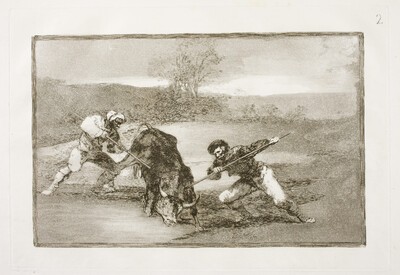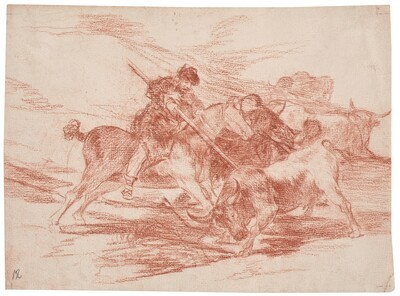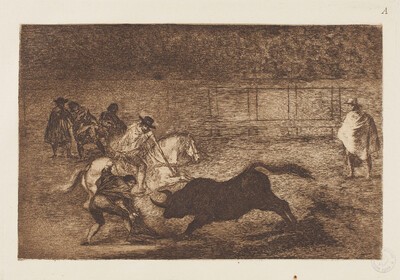- Cronología
- 1814 - 1816
- Dimensiones
- 250 x 353 mm
- Técnica y soporte
- Aguafuerte, aguatinta, punta seca y buril
- Reconocimiento de la autoría de Goya
- Documented work
- Ficha: realización/revisión
- 02 Sep 2021 / 22 Jun 2023
- Inventario
- 225
1 ( print, upper right-hand corner)
Goya began work on his fourth series of engravings in 1814-1815, at the same time as the Desastres de la Guerra (Disasters of War) was being completed. Although the motives for the choice of subject matter are not clear, and may perhaps be ambivalent, the traditional explanation points, on the one hand, to their precarious economic situation, and on the other to a need for distraction and refuge, or evocation of more pleasant past times. In both cases, the bullfighting theme, not at all controversial in view of the reintroduction of censorship and the Inquisition in Spain, was also ideal due to its potential sales success and the painter's proven fondness for the fiesta, although some authors, including Nigel Glendinning, point to a possible criticism of the violence turned into a spectacle ("the disasters of the party"), or a universal report of any type of violence generated by human beings (as is war), an enlightened vision in which friends of the artist participated, such as Gaspar Melchor de Jovellanos, author of a Memoir for the arrangement of the police of spectacles and amusements, and on their origin in Spain (1790), in which bullfights were condemned with economic and moral arguments, or José Vargas Ponce, who wrote a Dissertation on bullfights (not published until 1961). Finally, other specialists have allowed the Bullfighting as the result of a personal crisis of the artist, and more recently the political context has been pointed out in order to interpret the series and approach the true intentions of its author, which could well have been various and even contradictory, but in any case openend a new path towards modernity in the representation of this genre, capturing the essence of the party, with its positive and negative aspects, vindicating the role of the people and highlighting its symbolic force and universal dimension.
On the other hand, its necessary to remember that, after the War of Independence and with the return of Fernando VII, there had been a resurgence of bullfighting, which had been prohibited between 1805 and 1808.
It is very plausible that Juan Agustín Ceán Bermúdez -a well-known anti-bullfighting activist- participated in the overall conception of the series, and in fact Goya gave him a set of proofs, the so-called "Ceán Album" (London, British Museum), in which two engravings were included, one of them titled Way of flying -edited later with the Disparates, whose titles, proposed by Ceán himself, present small variations with those published in the preliminary printed sheet of the 1816 edition. may have drawn inspiration for the choice of subjects and titles from well-known bullfighting publications at the time, such as Historical Letter on the Origin and Progress of Bullfighting in Spain (Madrid, 1777; reed. in 1801) by Nicolás F. de Moratín or The Art of Bullfighting on Horseback and on Foot (Madrid, 1804) by the master Pepe Hillo (José Delgado).
The announcement of the sale of the edition, composed of 33 engravings under the title Collection of prints invented and engraved with etching by Mr. Francisco de Goya, painter of Chamber of S.M., in which diverse bullfighting suertes are represented, and lances occurred on the occasion of those functions in our bullrings..., appeared on October 28, 1816 in the Diario de Madrid and on December 31 of that year in the Gaceta de Madrid.
As for the plates, they could have suffered the same fate as does of the Disasters and the Disparates. When Goya left for France, they remained at the "Quinta del Sordo" and became the property of his son Javier, who kept them until his death in 1854. They were inherited by his grandson Mariano, who sold them on. In 1855 we know that they were owned by León Pérez de Bobadilla, who paid for a print run of two thousand prints at the price of 17 reales a hundred. A year later, Bobadilla offered them to the Ministry of Public Works, which forwarded them to the San Fernando Royal Academy of Fine Arts, which decided not to acquire them because of the abundance of prints devoted to bulls, and he also offered them to the Chalcography, which did not acquire them either. Before 1876 they were sold in Paris to Loizelet, who printed the series for the third time, including seven new prints corresponding to scenes engraved on the back of the plates. On his death in 1886 they passed into the hands of a German dealer, M. Bhin, and before 1899 they were bought by the engraver Ricardo de los Ríos, who took them to Madrid, where a new edition was made in 1905, after which they returned to Paris. In 1914 Carlos Verger, on behalf of Ricardo de los Ríos, offered the 33 plates to the State for 15,000 pesetas, but in the end the acquisition did not take place. In 1920 the Fine Arts Circle of Madrid decide to adquire them and Ricardo de los Ríos took them to Madrid, selling them for 17000 pesetas. The Circle made a print run in 1921 and another in 1928. During the Civil War, the coppers were taken to the National Chalcography to protect them and in 1937 a new print run of 40 collections was made, which remained on deposit at this institution. It was not until 1979 that the San Fernando Royal Academy of Fine Arts bought them and they became part of its collections. In 1983 the plates were deaccessioned, cleaned of old inks, chromed by electrolytic process and 200 collections were thrown away.
In addition to the 33 prints of the first edition, from the third edition onwards the seven compositions found on the reverse of the plates of prints no. 1, 2, 6, 7, 11, 16 and 21 were added, prints that had initially been discarded due to faults in the etching of the aquatint and which are identified with a letter (A-G) instead of a number. Five plates, for which proofs have been preserved, have also disappeared.
In the Public Library of Boston (USA) there is a copy with the titles in italics handwritten in pencil by Goya on the prints.
The first plate of the first print in the series is preserved in the National Chalcography (part of the Royal Academy of Fine Arts of San Fernando), with Un caballero en plaza quebrando un rejoncillo con ayuda de un chulo (Tauromaquia A), engraved on the reverse.
Goya made multiple preparatory drawings for this series (about fifty), in red sanguine, which were owned by Valentín Carderera until they were bought by the Prado Museum in 1886. They show unity and give the impression of having been made in a continuous period.
The prints are all made in English copper plates of good quality, with the same measurements. All the compositions, except one, have a thick framing line.
The prints in the series can be classified into three groups: the first eleven are related to the legendary and historical origin of bullfighting in Spain, with the aboriginal settlers dedicated to the hunting of wild cattle and various episodes of bravery in the face of the beasts. The second group refers to scenes whose protagonists are the figures of the two main schools of bullfighting in the 18th century: the Navarre-Aragonese (with Juanito Apiñani and Martincho) and the Andalusian (with Pepe Hillo and Pedro Romero). And the third, whose prints are interspersed with those of the previous one, focuses on real or invented lances of the bullfight, many of them with a tragic outcome.
The dramatic character prevails in all the prints, intensified by the use of light and emptiness, which reaches its climax in the brutal encounter between the man and the beast. The compositions are of great vigor, movement and rawness, which increase in intensity as the series progresses towards the contemporary scenes, evidencing a clear desire for simplification and reduction to the essential.
The failure of sale of the series can be explained precisely by the innovative and difficult to understand graphic proposal of a very popular theme, which Goya approached as snapshots that do not follow a lineal narrative discourse or make concessions to the didactic, with unusual framing, breaking the distance and bringing the protagonists to the front, playing with gaps and whites, minimizing the anecdotal elements, avoiding the picturesque and costumbrist, avoiding color and prioritizing the suggestion over the explicit representation. Nothing to do, therefore, with prints like those that made up the Collection of the main tricks of a bullfight (1787-1790), drawn and engraved in sweet carving by Antonio Carnicero, a series of strong genre character that had considerable impact and was copied by various Spanish and foreign engravers.
This first print, entitled How the ancient Spaniards hunted bulls on horseback in the countryside belongs to the first block of "historical" scenes (nos. 1-11) and narrates the way in which the Spaniards hunted bulls in the past. The scene is located in a wild landscape, where a horseman lances a bull while his companions try to bend him with a rope entangled in his head. There are many differences with the preparatory drawing, also titled How the ancient Spaniards hunted bulls on horseback in the countryside, since in this one four bulls appear and the postures of the characters are different.
The way the man holds the pike serves to emphasize the primitive character of the scene. The light is concentrated on a part of the sky and on the horse of the main character. The rest of the scene is, in its final version, blurred by the use of aquatint. The bulls are represented in a truthful way, full of life and without the stereotyped forms used until then.
-
Exposición de la obra grabada de GoyaSociedad Española de Amigos del ArteMadrid1928catalogue by Miguel Velasco Aguirre
-
Grabados y dibujos de Goya en la Biblioteca NacionalBiblioteca NacionalMadrid1946catalogue Elena Páez Ríos
-
Madrid1952
-
Goya. Drawings, Etchings and LithographsGoya. DrawingsLondon1954from June 12th to July 25th 1954
-
Brussels International ExhibitionBrussels1958
-
Goya: zeichnungen, radierungen, lithographienInternational TageIngelheim1966exhibition displayed from May 7th to June 5 th 1966
-
Goya en la Biblioteca Nacional. Exposición de grabados y dibujos en el sesquicentenario de su muerteBiblioteca NacionalMadrid1978May - June 1978
-
50 Gravuras de GoyaFundaçao Calouste GulbenkianLisboa1979
-
Grabados de Goya: colección propiedad de la Biblioteca Nacional, que se conserva en su Gabinete deCasa de la Amistad de MoscúMoscow1979exhibition displayed from January 18th to 31st 1979
-
1984
-
Milwakee1986
-
Madrid1987
-
Madrid1990cat. 15
-
Goya grabadorFundación Juan MarchMadrid1994consultant editors Alfonso E. Pérez Sánchez and Julián Gállego, from January 14th to March 20th 1994
-
Roma1994
-
Goya grabadorMuseo del Grabado Español ContemporáneoMarbella1996from March 8th to May 5th 1996
-
Zaragoza1996
-
Ydioma universal: Goya en la Biblioteca NacionalBiblioteca NacionalMadrid1996from September 19th to December 15th 1996cat. 263
-
Schlaf der Vernunft. Original radierungen von Francisco de GoyaMunich2000
-
Madrid2002
-
Madrid2002
-
Madrid2005
-
Goya en tiempos de guerraMuseo Nacional del PradoMadrid2008consultant editor Manuela B. Mena Marqués, from April 14th to July 13th 2008cat. 143
-
Bilbao2012
-
Goya et la modernitéPinacothèque de ParisParís2013from October 11st 2013 to March 16th 2014cat. 21
-
Zaragoza2017
-
New York2021
-
ZaragozaTip. del Hospicio1926
-
1946pp. 177-216
-
MadridAfrodisio Aguado1950
-
OxfordBruno Cassirer1964vol. II, 1964, pp. 305-361, cat. 204-247
-
Vie et ouvre de Francisco de GoyaParísOffice du livre1970pp. 227- 230, cat. 1149-1243
-
BarcelonaEditorial Gustavo Gili, S.A1974
-
The Changing image: Prints by Francisco GoyaBostonMuseum of Fine Arts1974
-
Dibujos de Goya, 2 volsBarcelonaNoguer1975pp. 327-429, cat. 240-288
-
ZaragozaInstitución “Fernando el Católico”1981
-
Goya's prints: the Tomás Harris Collection in the British MuseumLondonBritish Museum Press1981
-
VeneciaCollezione Peggy Guggenheim1985
-
MadridTurner1989
-
Goya, toros y torerosMadridMinisterio de Cultura, Comunidad de Madrid1990p. 84
-
MadridCaser-Turner1992
-
MadridCaser-Turner1992
-
Museo del Prado. Catálogo de las EstampasMadridMuseo del Prado y Ministerio de Cultura1992
-
Goya ¡Qué valor! Caprichos. Desastres. Tauromaquia. DisparatesCaja de Ahorros de la Inmaculada1996pp. 195-229
-
Catálogo de las estampas de Goya en la Biblioteca NacionalMadridMinisterio de Educación y Cultura, Biblioteca Nacional1996pp. 193-227, cat. 317-371
-
Ydioma universal: Goya en la Biblioteca NacionalMadridBiblioteca Nacional, Sociedad Estatal Goya 96 y Lunwerg1996p. 238
-
MadridMuseo Nacional del Prado2001
-
ValenciaDiputación de Valencia2003
-
MadridElectra2007
-
Goya en tiempos de guerraMadridMuseo Nacional del Prado2008pp. 412-413
-
ZaragozaInstitución “Fernando el Católico”2013pp. 177-191
-
ParísPinacoteca de París2013p. 102
-
Goya. In the Norton Simon MuseumPasadenaNorton Simon Museum2016pp. 186-201



